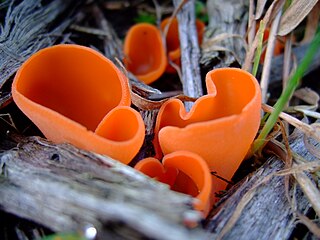
Rosaceae, the rose family, is a medium-sized family of flowering plants, including 4,828 known species in 91 genera.

Streptophyta, informally the streptophytes, is a clade of plants. The composition of the clade varies considerably between authors, but the definition employed here includes land plants and all green algae except the Chlorophyta and possibly the more basal Mesostigmatophyceae, Chlorokybophyceae, and Spirotaenia.

Dothideomycetes is the largest and most diverse class of ascomycete fungi. It comprises 11 orders 90 families, 1300 genera and over 19,000 known species. Traditionally, most of its members were included in the loculoascomycetes, which is not part of the currently accepted classification. This indicates that several traditional morphological features in the class are not unique and DNA sequence comparisons are important to define the class.

Pezizomycetes are a class of fungi within the division Ascomycota.

Botryosphaeria dothidea is a plant pathogen that causes the formation of cankers on a wide variety of tree and shrub species. It has been reported on several hundred plant hosts and on all continents except Antarctica. B. dothidea was redefined in 2004, and some reports of its host range from prior to that time likely include species that have since been placed in another genus. Even so, B. dothidea has since been identified on a number of woody plants—including grape, mango, olive, eucalyptus, maple, and oak, among others—and is still expected to have a broad geographical distribution. While it is best known as a pathogen, the species has also been identified as an endophyte, existing in association with plant tissues on which disease symptoms were not observed. It can colonize some fruits, in addition to woody tissues.

Cochliobolus lunatus is a fungal plant pathogen that can cause disease in humans and other animals. The anamorph of this fungus is known as Curvularia lunata, while Cochliobolus lunatus denotes the teleomorph or sexual state. They are, however, the same biological entity. Cochliobolus lunatus is the most commonly reported species in clinical cases of reported Cochliobolus infection.

The Gomphales are an order of basidiomycete fungi. Some or all families belonging to Gomphales have been sometimes included in the order Phallales, the now-obsolete Ramariaceae was also previously included in Cantharellales. Recent phylogenetic analyses include in Gomphales the families of the original description of the order by Walter Jülich, with addition of Clavariadelphaceae. According to one 2008 estimate, the Gomphales contain 18 genera and 336 species.

Stagonospora is a genus of fungi clustering in the Phaeosphaeriaceae (Quaedvlieg). Several of the species in this genus are plant pathogens.

The Pleosporales is the largest order in the fungal class Dothideomycetes. By a 2008 estimate it contains 23 families, 332 genera and more than 4700 species. The majority of species are saprobes on decaying plant material in fresh water, marine, or terrestrial environments, but several species are also associated with living plants as parasites, epiphytes or endophytes. The best studied species cause plant diseases on important agricultural crops e.g. Cochliobolus heterostrophus, causing southern corn leaf blight on maize, Phaeosphaeria nodorum causing glume blotch on wheat and Leptosphaeria maculans causing a stem canker on cabbage crops (Brassica). Some species of Pleosporales occur on animal dung and a small number occur as lichens and rock-inhabiting fungi.

Dothideomycetidae is a subclass of Dothideomycetes consisting of three orders: Dothideales, Myriangiales and Capnodiales. The cavities of the sexual structures do not have vertical cells growing between the sac-like cells bearing the sexual spores (asci).

Pleosporomycetidae is a subclass of Dothideomycetes consisting of four orders: Pleosporales, Hysteriales, Mytilinidiales, and Jahnulales. One of its defining features is the presence of pseudoparaphyses. These are sterile cells extending down from the upper portion of the cavity inside sexual structures containing the sac-like asci with sexually produced spores (ascospores). Pseudoparaphyses are initially attached at both their ends, but sometimes the upper part may become free. Some orders and families where these cells are present remain outside the subclass since DNA based phylogenies cannot place them with confidence. However they could conceivably be included within Pleosporomycetidae in future.
The Phaeotrichaceae are a family of fungi previously considered to be in the order Pleosporales, but now excluded. Taxa have a widespread distribution and are saprobic, on herbivore dung.

Lophiostoma is a genus of ascomycetous fungi in the family Lophiostomataceae.

Annulatascus is a genus of fungi in the Annulatascaceae family of the Ascomycota. The relationship of this taxon to other taxa within the Sordariomycetes class is unknown, and it has not yet been placed with certainty into any order. The genus is characterized by taxa that are saprobic on submerged, decaying plant material in freshwater habitats. Morphologically the taxa possess dark brown to black perithecia, long tapering hyaline septate paraphyses, eight-spored asci with relatively massive J- apical rings, and ascospores that may or may not possess gelatinous sheaths or appendages. There are currently 17 species included in the genus.

The Didymellaceae are a family of fungi in the order Pleosporales.

Glomerellaceae is a monotypic family of fungi in the class Sordariomycetes that contains only one genus, Colletotrichum.
John Alan (Jack) Elix emeritus professor in chemistry at the Australian National University, is an organic chemist who has contributed in many fields: lichenology, lichen chemotaxonomy, plant physiology and biodiversity and natural product chemistry. He has authored 2282 species names, and 67 genera in the field of mycology.
Anguillospora is a genus of fungi belonging to the family Amniculicolaceae. It was circumscribed by Cecil Terence Ingold in 1942, with Anguillospora longissima assigned as the type species. It was found as a root endophytic fungus in the plant Equisetum scirpoides. It is related to the genera Amniculicola and Lophiostoma. The genus has a cosmopolitan distribution.
Dacampiaceae is a family of fungi belonging to the order Pleosporales. The genus was first described in 1855 by Gustav Wilhelm Körber.
Lentithecium is a genus of fungi belonging to the family Lentitheciaceae.














